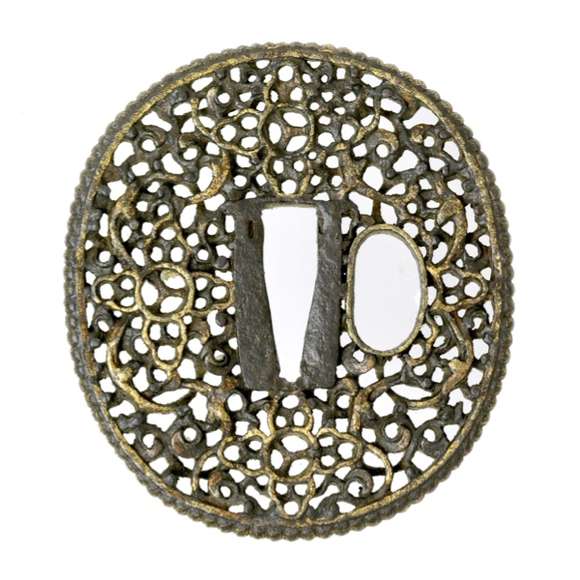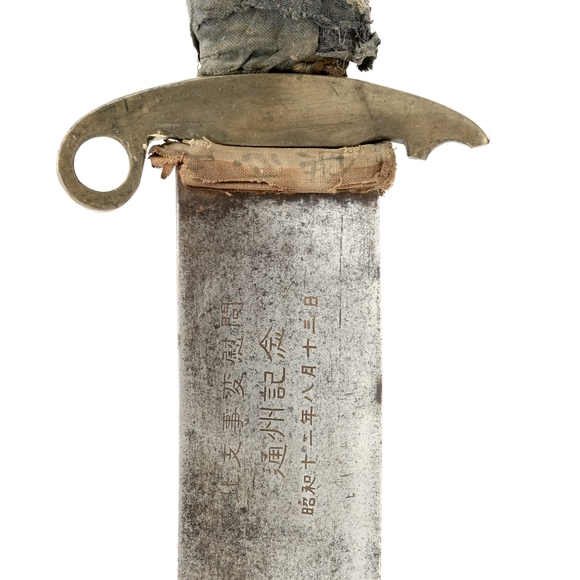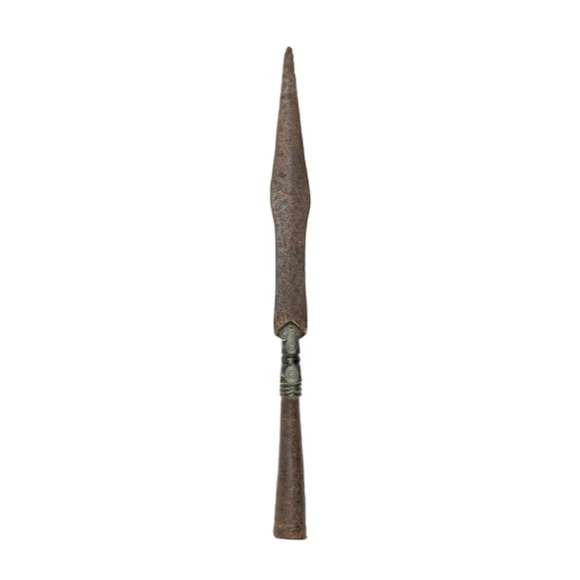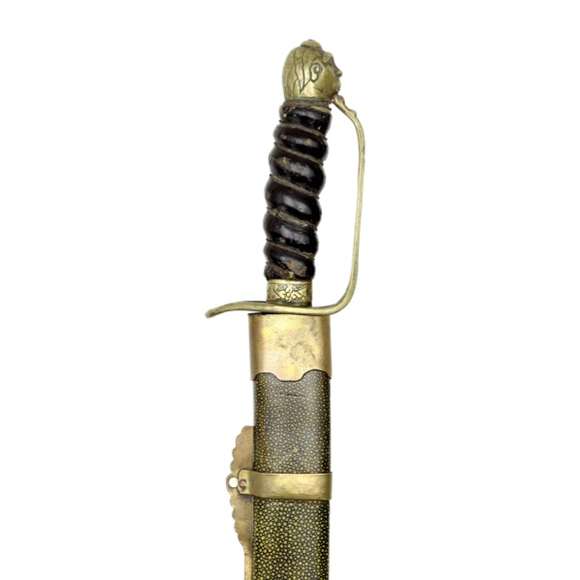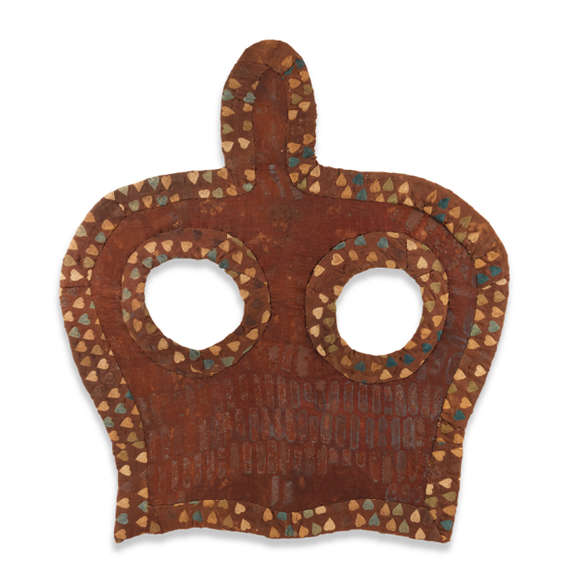A very rare Chinese saber guard dating from the height of the Qing dynasty.

74.1 cm / 29.2 inch
58.5 cm / 23 inch
forte 16 mm
middle 13 mm
near tip 9 mm
1220 grams
11.2 cm from guard
(handle side)
Qing dynasty, China.
Steel, iron.
18th or 19th century
Introduction
In Chinese martial culture, there has long been a distinction between two heavy maces, the 鞭 (biān) and the 鐧 (jiǎn). The former always has a bamboo-sectioned blade, sometimes of round and sometimes of angular cross-section. The latter tends to have a smooth blade of angular (often square or rectangular) cross-section, sometimes with grooves.
Large, two handed versions of both bian and jian were in military use in the Ming dynasty. By the Qing, we only find references to single handed versions. The bian remained in use in the Qing special forces of the Jianruiying, while sets of double jian remained in use among the Green Standard Army.1
Notes to introduction
1. See: Yunlu 允祿 et al., eds.; Huangchao liqi tushi (皇朝禮器圖式) or "Illustrated Ceremonial Paraphernalia for our Dynasty", 1766 woodblock print edition, based on a 1759 manuscript. Chapter 15.
Description
Here’s a pretty good example of a Chinese mace of the jiān (鐧) type. It has a tapering blade, hollow ground on each side to make the edges slightly sharper. It terminated in an attractive finial. The handle is a thick iron tube, heavily patinated, that looks like it hasn’t been wrapped for a long time. The patina on the exposed handle is lovely and it provides good grip as it is, so perhaps the piece was just used like this. The handle sits between two solid iron flattened spheres with grooved decoration, serving as guard and pommel. At the end of the pommel is a small loop for the attachment of tassel or lanyard.
The somewhat similar maces that appear the 1766 Huangchao Liqi Tushi were used by the all-Han Green Standard Army. This army was often deployed in an internal peacekeeping role, for which these maces were probably also used. It has good size, weight, and balance for heavy hitting yet quick handling. Ideal for non-lethal security purposes where one may run into those armed with lethal weapons that you need to take out, ideally rendering them harmless without killing them.
These maces did not change shape much, if anything, over a long period of time so they are pretty hard to date. Judging from style, workmanship and patina my feeling is that it’s most likely from the late 19th century. This is a conservative guess, it may well be older and just very well preserved, which happens. Most of these on the market are of rather coarse, village grade manufacture. This is a rarer example of a somewhat higher quality.
Conclusion
A nice example of a rare Chinese blunt weapon, the mace. Of good weight, size, and handling characteristics. These nimble weapons were probably used by soldiers and security personally that were in situations where one had to neutralize armed opponents while trying to avoid killing them. It is of better quality manufacture than most, with some attractive geometric details.
鐧 (jiǎn)" src="http://archive.mandarinmansion.com/images/chinese/jian-mace-2/chinese-mace-jian.jpg" width="653" />
鐧 (jiǎn)" src="http://archive.mandarinmansion.com/images/chinese/jian-mace-2/chinese-mace-jian1.jpg" width="653" />
鐧 (jiǎn)" src="http://archive.mandarinmansion.com/images/chinese/jian-mace-2/chinese-mace-jian2.jpg" width="653" />
鐧 (jiǎn)" src="http://archive.mandarinmansion.com/images/chinese/jian-mace-2/chinese-mace-jian3.jpg" width="653" />
鐧 (jiǎn)" src="http://archive.mandarinmansion.com/images/chinese/jian-mace-2/chinese-mace-jian4.jpg" width="653" />
鐧 (jiǎn)" src="http://archive.mandarinmansion.com/images/chinese/jian-mace-2/chinese-mace-jian5.jpg" width="653" />
鐧 (jiǎn)" src="http://archive.mandarinmansion.com/images/chinese/jian-mace-2/chinese-mace-jian6.jpg" width="653" />
鐧 (jiǎn)" src="http://archive.mandarinmansion.com/images/chinese/jian-mace-2/chinese-mace-jian7.jpg" width="653" />
鐧 (jiǎn)" src="http://archive.mandarinmansion.com/images/chinese/jian-mace-2/chinese-mace-jian8.jpg" width="653" />
鐧 (jiǎn)" src="http://archive.mandarinmansion.com/images/chinese/jian-mace-2/chinese-mace-jian9.jpg" width="653" />
鐧 (jiǎn)" src="http://archive.mandarinmansion.com/images/chinese/jian-mace-2/chinese-mace-jian10.jpg" width="653" />
鐧 (jiǎn)" src="http://archive.mandarinmansion.com/images/chinese/jian-mace-2/chinese-mace-jian11.jpg" width="653" />
鐧 (jiǎn)" src="http://archive.mandarinmansion.com/images/chinese/jian-mace-2/chinese-mace-jian12.jpg" width="653" />
鐧 (jiǎn)" src="http://archive.mandarinmansion.com/images/chinese/jian-mace-2/chinese-mace-jian13.jpg" width="653" />
鐧 (jiǎn)" src="http://archive.mandarinmansion.com/images/chinese/jian-mace-2/chinese-mace-jian14.jpg" width="653" />
With markings attributing it to the Tongzhou incident and a Japanese surrender tag.
Of classic shape, with a leaf-shaped blade on a socket, connected by a cast bronze base.
A standard pattern Qing military saber, but with the rare addition of a label in Manchu.
Silk horse mask from the Xianbei ruled dynasty which ruled northern China from 386 to 534 A.D.

